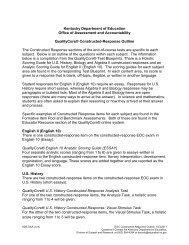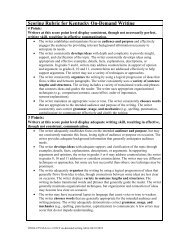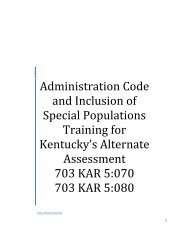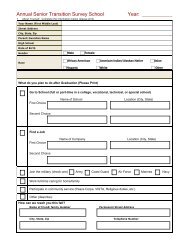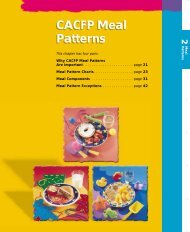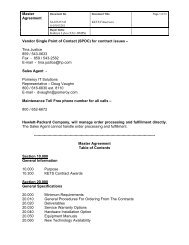Standards with Progressions grades K-HS v. 1.3 - Kentucky ...
Standards with Progressions grades K-HS v. 1.3 - Kentucky ...
Standards with Progressions grades K-HS v. 1.3 - Kentucky ...
- No tags were found...
You also want an ePaper? Increase the reach of your titles
YUMPU automatically turns print PDFs into web optimized ePapers that Google loves.
<strong>Progressions</strong> by Domains, Clusters and <strong>Standards</strong>, <strong>grades</strong> 6 – 8<br />
Ratios and Proportional Relationships<br />
Grade 6 Grade 7 Grade 8<br />
Understand ratio concepts and use ratio reasoning to solve problems.<br />
6.RP.1: Understand the concept of a ratio and use ratio language to<br />
describe a ratio relationship between two quantities. For<br />
example, “The ratio of wings to beaks in the bird house at the zoo<br />
was 2:1, because for every 2 wings there was 1 beak.” “For every<br />
vote candidate A received, candidate C received nearly three<br />
votes.”<br />
6.RP.2: Understand the concept of a unit rate a/b associated <strong>with</strong> a ratio<br />
a:b <strong>with</strong> b ≠ 0, and use rate language in the context of a ratio<br />
relationship. For example, “This recipe has a ratio of 3 cups of<br />
flour to 4 cups of sugar, so there is 3/4 cup of flour for each cup of<br />
sugar.” “We paid $75 for 15 hamburgers, which is a rate of $5 per<br />
hamburger.” (Note: Expectations for unit rates in this grade are<br />
limited to non-complex fractions.)<br />
6.RP.3: Use ratio and rate reasoning to solve real-world and<br />
mathematical problems, e.g., by reasoning about tables of<br />
equivalent ratios, tape diagrams, double number line diagrams,<br />
or equations.<br />
a. Make tables of equivalent ratios relating quantities <strong>with</strong><br />
whole-number measurements, find missing values in the<br />
tables, and plot the pairs of values on the coordinate plane.<br />
Use tables to compare ratios.<br />
b. Solve unit rate problems including those involving unit<br />
pricing and constant speed. For example, if it took 7 hours to<br />
mow 4 lawns, then at that rate, how many lawns could be<br />
mowed in 35 hours At what rate were lawns being mowed<br />
c. Find a percent of a quantity as a rate per 100 (e.g., 30% of a<br />
quantity means 30/100 times the quantity); solve problems<br />
involving finding the whole, given a part and the percent.<br />
d. Use ratio reasoning to convert measurement units;<br />
manipulate and transform units appropriately when<br />
multiplying or dividing quantities.<br />
Analyze proportional relationships and use them to solve real-world and<br />
mathematical problems.<br />
7.RP.1: Compute unit rates associated <strong>with</strong> ratios of fractions, including<br />
ratios of lengths, areas and other quantities measured in like or<br />
different units. For example, if a person walks 1/2 mile in each 1/4<br />
hour, compute the unit rate as the complex fraction (1/2)/(1/4)<br />
miles per hour, equivalently 2 miles per hour.<br />
7.RP.2: Recognize and represent proportional relationships between<br />
quantities.<br />
a. Decide whether two quantities are in a proportional<br />
relationship, e.g., by testing for equivalent ratios in a table or<br />
graphing on a coordinate plane and observing whether the<br />
graph is a straight line through the origin.<br />
b. Identify the constant of proportionality (unit rate) in tables,<br />
graphs, equations, diagrams, and verbal descriptions of<br />
proportional relationships.<br />
c. Represent proportional relationships by equations. For<br />
example, if total cost t is proportional to the number n of<br />
items purchased at a constant price p, the relationship<br />
between the total cost and the number of items can be<br />
expressed as t = pn.<br />
d. Explain what a point (x, y) on the graph of a proportional<br />
relationship means in terms of the situation, <strong>with</strong> special<br />
attention to the points (0, 0) and (1, r) where r is the unit<br />
rate.<br />
7.RP.3: Use proportional relationships to solve multistep ratio and percent<br />
problems. Examples: simple interest, tax, markups and markdowns,<br />
gratuities and commissions, fees, percent increase and decrease,<br />
percent error.<br />
None<br />
<strong>Kentucky</strong> Department of Education<br />
33 | P a g e




